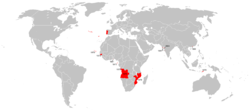Estado Novo (Portugal)
The Estado Novo, also known as the Second Portuguese Republic, was a corporatist regime in Portugal from 1933 to 1974 until Carnation Revolution. It evolved from the Ditadura Nacional that was formed after the coup d'état of 28 May 1926 against the democratic First Portuguese Republic. The Estado Novo was conservativee and autocratic, it was developed by António de Oliveira Salazar, who was President of the Council of Ministers from 1932 until 1968 due to illnesses.
Portuguese Republic República Portuguesa | |||||||||
|---|---|---|---|---|---|---|---|---|---|
| 1933–1974 | |||||||||
| Motto: Deus, Pátria e Familia ("God, Fatherland and Family")[1] | |||||||||
| Anthem: A Portuguesa ("The Portuguese") | |||||||||
| Flag of the National Union: | |||||||||
 | |||||||||
| Capital | Lisbon | ||||||||
| Common languages | Portuguese | ||||||||
| Religion | Roman Catholicism (Official) | ||||||||
| Government | Unitary Salazarist republic under an authoritarian dictatorship | ||||||||
| President | |||||||||
• 1926–1951 | Óscar Carmona | ||||||||
• 1951–1958 | Francisco Craveiro Lopes | ||||||||
• 1958–1974 | Américo Tomás | ||||||||
| Prime Minister | |||||||||
• 1932–1968 | António de Oliveira Salazar | ||||||||
• 1968–1974 | Marcello Caetano | ||||||||
| Legislature | |||||||||
| History | |||||||||
• Constitutional referendum | 19 March 1933 | ||||||||
• Established | 11 April 1933 | ||||||||
• Admitted to the United Nations | 14 December 1955 | ||||||||
| 25 April 1974 | |||||||||
| Currency | Portuguese escudo | ||||||||
| |||||||||
| Today part of | Third Portuguese Republic | ||||||||
The Estado Novo was one of the longest-surviving authoritarian regimes in Europe, it was conservative, corporatist, and nationalist and traditionalist. Estado Novo had very colonialist foreign policies, with colonies oversea like Angola, Mozambique, and other Portuguese territories. During this period, Portugal tried to expand its empire, using the Portuguese Colonial War to combat self-determination and independence of colonies.[2]
After four decades of dictatorship, on 25 April 1974, the Carnation Revolution in Lisbon, a military coup organized by Portuguese military officers of the Armed Forces Movement overthrew the Estado Novo regime.
Economy
changeFrom 1950 until Salazar's death in 1970, Portugal saw its GDP per capita increase at an annual average rate of 5.7 per cent.[3] By the fall of the Estado Novo in 1974, Portugal had the lowest per capita income in Western Europe and the highest rate of preventable deaths and infant mortality rate in Europe.[4][5][6]
References
change- ↑ Gallagher, Tom (1983). Portugal: A Twentieth-century Interpretation. Manchester University Press. pp. 60, 99. ISBN 978-0-7190-0876-4.
- ↑ "Portugal não é um país pequeno: superfície do império colonial português comparada com a dos principais países da Europa, Penafiel, [ca 1935] - Biblioteca Nacional Digital". purl.pt. Archived from the original on 14 May 2011.
- ↑ Mattoso, José; Rosas, Fernando (1994). História de Portugal: o Estado Novo (in Portuguese). Vol. VII. Lisbon: Estampa. p. 474. ISBN 978-9723310863.
- ↑ Perreira Gomes, Isabel; Amorim, José Pedro; Correira, José Alberto; Menezes, Isabel (1 January 2016). "The Portuguese literacy campaigns after the Carnation Revolution (1974-1977)". Journal of Social Science Education. 14 (2): 69–80. Retrieved 16 January 2018.
- ↑ Neave, Guy; Amaral, Alberto (21 December 2011). Higher Education in Portugal 1974-2009: A Nation, a Generation (2012 ed.). Springer Science & Business Media. pp. 95, 102. ISBN 978-9400721340. Retrieved 16 January 2018.
- ↑ Whitman, Alden (28 July 1970). "Antonio Salazar: A Quiet Autocrat Who Held Power in Portugal for 40 Years". The New York Times. Retrieved 19 January 2018.


